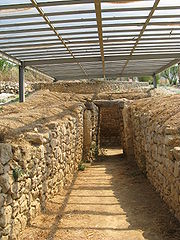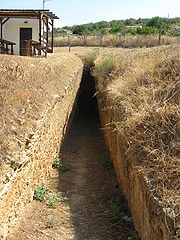
Dendra
Encyclopedia

Midea, Greece
Midea is a village and a former municipality in Argolis, Peloponnese, Greece. Since the 2011 local government reform it is part of the municipality Nafplio, of which it is a municipal unit. with a population of 6,724...
in the Argolid
Argolis
Argolis is one of the regional units of Greece. It is part of the region of Peloponnese. It is situated in the eastern part of the Peloponnese peninsula.-Geography:...
, Greece
Greece
Greece , officially the Hellenic Republic , and historically Hellas or the Republic of Greece in English, is a country in southeastern Europe....
.
The site has a history stretching back at least to the early Bronze Age
Bronze Age
The Bronze Age is a period characterized by the use of copper and its alloy bronze as the chief hard materials in the manufacture of some implements and weapons. Chronologically, it stands between the Stone Age and Iron Age...
and is significant for the Bronze Age cemetery
Cemetery
A cemetery is a place in which dead bodies and cremated remains are buried. The term "cemetery" implies that the land is specifically designated as a burying ground. Cemeteries in the Western world are where the final ceremonies of death are observed...
excavated by Swedish
Sweden
Sweden , officially the Kingdom of Sweden , is a Nordic country on the Scandinavian Peninsula in Northern Europe. Sweden borders with Norway and Finland and is connected to Denmark by a bridge-tunnel across the Öresund....
archaeologist Axel W. Persson
Axel W Persson
Axel Waldemar Persson was a Swedish archaeologist, a professor of classical archaeology and ancient history at Uppsala University from 1925 to 1951...
in the first half of the 20th century. Persson excavated an unplundered tholos tomb and many Mycenaean chamber tomb
Mycenaean chamber tomb
The term chamber tomb is used to refer to a form of mortuary architecture in use in the Late Bronze Age of the areas under the cultural influence of the Aegean. This is based on a previous form of architecture made by the Akkadians, specifically those located in Old Babylonia. This progenitor to...
s, presumably belonging to the ruling classes having their dwelling at the nearby citadel
Citadel
A citadel is a fortress for protecting a town, sometimes incorporating a castle. The term derives from the same Latin root as the word "city", civis, meaning citizen....
of Midea
Midea (Argolid)
Midea is the name given to the bronze age citadel standing above the village of the same name in the Argolid in Greece. The citadel is one of the largest and best preserved Mycenaean citadels...
.

Dendra panoply
The Dendra panoply or Dendra armour is an example of Mycenean-era full-body armour made of bronze plates uncovered in the village of Dendra in the Argolid, Greece.- Description :...
of bronze armour, currently exhibited at the Archaeological Museum in nearby Nafplio. Later excavations also brought to light Bronze Age tumulus
Tumulus
A tumulus is a mound of earth and stones raised over a grave or graves. Tumuli are also known as barrows, burial mounds, Hügelgrab or kurgans, and can be found throughout much of the world. A tumulus composed largely or entirely of stones is usually referred to as a cairn...
burials which included sacrificed horse
Horse
The horse is one of two extant subspecies of Equus ferus, or the wild horse. It is a single-hooved mammal belonging to the taxonomic family Equidae. The horse has evolved over the past 45 to 55 million years from a small multi-toed creature into the large, single-toed animal of today...
s.
Sources
- P. Mack Crew, J.B. Bury, I.E.S. Edwards, C.J. Gadd, John Boardman, and N.G.L. Hammond. The Cambridge Ancient History: c.1800-1380 B.C Vol. II, pt. 2: c.1380-1000 B.C. (Cambridge University Press), 1975. ISBN 0521086914

